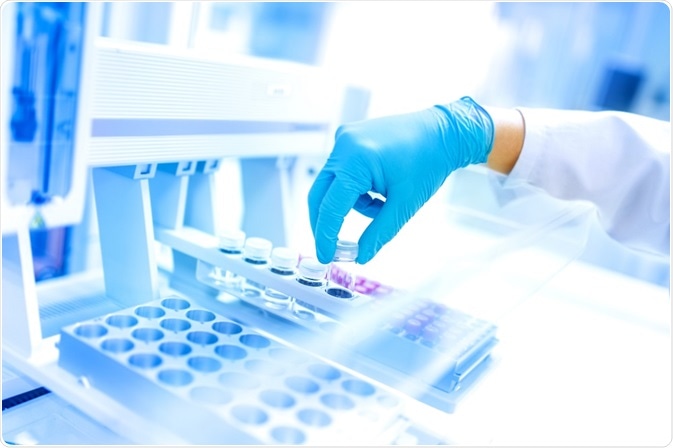Bioorthogonal chemical reporters are small exogenous reporters which do not chemically modify the biomolecules they are tagged to. Their small size means they do not interfere with gene expression or protein function and can therefore produce more reliable results in research studies.
 Image Credit: bogdanhoda / Shutterstock
Image Credit: bogdanhoda / Shutterstock
One of the ways to understand cellular processes is to track different molecules using reporters. Tagging a protein with Green Florescent Protein (GFP) is one of the most popular ways of tracing the location and movement of proteins within a cell.
GFP fusion proteins are very widely used as its DNA sequence can be added to the end of a gene, and it does not require any additional factors. However, the size of GFP is quite large which could possibly affect the expression and function of the protein to which it is tagged.
Also, tags like GFP can only be applied to protein and not other biomolecules such as glycans and lipids. Similarly, antibody conjugates are another method to track biomolecules inside cells. Again, the size is a considerable factor here which could modify the same parameters it tries to measure.
To this end, small molecules to tag and report the localization of biomolecules is an increasingly interesting area of research. Small molecules can traverse intra- and intercellular membranes easily and do not affect the mobility and properties of the molecules it is reporting. One such approach is use of bioorthogonal chemical reporters.
Designing bioorthogonal chemical reporters
The small reporter is ideally tagged to a target scaffold and does not induce any structural changes. Usually the target scaffolds are selected such that they are used by the cellular machinery. For example, one of the target scaffolds is amino acids, which carry the orthogonal chemical groups. These amino acids are employed by the cell during the translation of proteins.
Another example is the use of monosaccharaides (scaffold) carrying a chemical reporters which is incorporated into the cell surface glycans by the cell. Some of the existing bioorthogonal chemical reporters are discussed below.
Bioorthogonal peptide sequences
One of the bioorthogonal chemical reporters is a peptide sequence which consists of a tetracysteine motif (CCXXCC), where XX can be any two amino acids, proline and glycine are desirable.
This hexapeptide reporter is fused to the target protein gene and expressed in cells. It is much smaller than GFP and provides a viable alternative without inducing structural perturbations in the target protein .
Ketones and aldehydes
Ketones and aldehydes as chemical reporters can tag glycans and secondary metabolites as well as proteins. Despite the possibility of ketone and aldehyde condensation reactions, this is usually limited in living organisms as it requires pH of 5-6, which is not viable for most living cells.
They are best used on cell surfaces and extracellular environment, as metabolites based on ketones and aldehydes are present within the cell. Therefore, ketone and aldehydes fall under the category of ‘biorestricted chemical reporters’.
Azides
Azides are another type of viable chemical reporter. They are abiotic and not present in living tissue. They do not react with water or undergo oxidation or react with amines and nucleophiles.
Although they can undergo reduction, it requires vigorous heating (100°C). They are very stable at physiological temperatures and thus, are viable chemical reporters. They are currently widely used as drugs, like AZT.
Introduction of bioorthogonal chemical reporters into biomolecules
As ketones, aldehydes and azides are not naturally present in the 20 natural amino acids, the incorporation of these groups into proteins involves the addition of unnatural amino acids. For example, one of the ways of incorporating unnatural amino acid is to replace the natural amino acid with its modified analogue which contains one of these residues.
To further avoid competition with natural amino acid, the bacteria can be made auxotrophic for a particular amino acid before a closely related unnatural analogue is added. This means that the bacteria are made to require the presence of the particular amino acid in order to be able to grow. Therefore, the bacteria then incorporates the unnatural amino acid into the proteins made during growth.
Similarly, these chemical groups can be added to lipids by placing these chemical groups to farnesylated proteins. The farnesyl group is an isoprenoid lipid moiety which is post-translationally added to proteins. Thus, different orthogonal chemical groups can be added to target groups if their biosysthetic pathway is tolerant of precursors which have been modified.
Bioorthogonal chemical reporters to study protein function
Apart from using these reporter to study target molecule localization, they have also been used to analyse enzyme function where the reporter visualizes the catalytic activity rather than localisation.
Bioorthogonal chemical reporters have far reaching applications to analyze target proteins without inducing chemical and structural modifications. They have to be chemically selective (i.e. not bind non-specifically), should not degrade quickly inside a cell, and should not accumulate inside cells. Thus, very few chemical reporters pass these stringent criteria.
However, several challenges remain in the use of these chemical reporters, primarily the competition between native substrates and unnaturally modified amino acids, lipids, and sugars. Still, they possess several advantages over fluorescent proteins like GFP which are currently widely used to report target molecules.
Further Reading